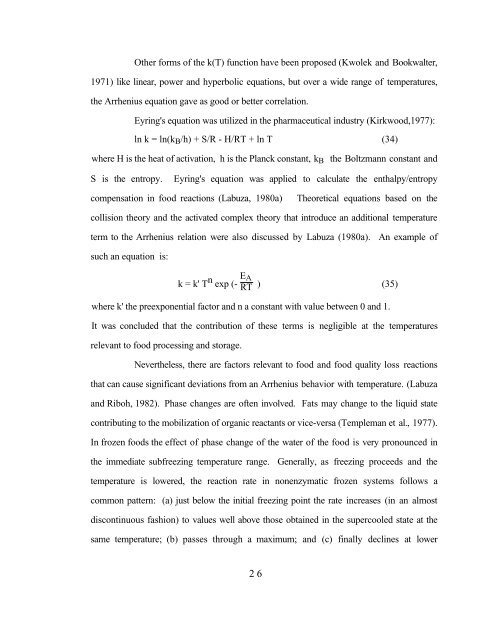the handbook of food engineering practice crc press chapter 10 ...
the handbook of food engineering practice crc press chapter 10 ...
the handbook of food engineering practice crc press chapter 10 ...
You also want an ePaper? Increase the reach of your titles
YUMPU automatically turns print PDFs into web optimized ePapers that Google loves.
O<strong>the</strong>r forms <strong>of</strong> <strong>the</strong> k(T) function have been proposed (Kwolek and Bookwalter,<br />
1971) like linear, power and hyperbolic equations, but over a wide range <strong>of</strong> temperatures,<br />
<strong>the</strong> Arrhenius equation gave as good or better correlation.<br />
Eyring's equation was utilized in <strong>the</strong> pharmaceutical industry (Kirkwood,1977):<br />
ln k = ln(k B /h) + S/R - H/RT + ln T (34)<br />
where H is <strong>the</strong> heat <strong>of</strong> activation, h is <strong>the</strong> Planck constant, k B <strong>the</strong> Boltzmann constant and<br />
S is <strong>the</strong> entropy. Eyring's equation was applied to calculate <strong>the</strong> enthalpy/entropy<br />
compensation in <strong>food</strong> reactions (Labuza, 1980a)<br />
Theoretical equations based on <strong>the</strong><br />
collision <strong>the</strong>ory and <strong>the</strong> activated complex <strong>the</strong>ory that introduce an additional temperature<br />
term to <strong>the</strong> Arrhenius relation were also discussed by Labuza (1980a). An example <strong>of</strong><br />
such an equation is:<br />
k = k' T n exp (- E A<br />
RT ) (35)<br />
where k' <strong>the</strong> preexponential factor and n a constant with value between 0 and 1.<br />
It was concluded that <strong>the</strong> contribution <strong>of</strong> <strong>the</strong>se terms is negligible at <strong>the</strong> temperatures<br />
relevant to <strong>food</strong> processing and storage.<br />
Never<strong>the</strong>less, <strong>the</strong>re are factors relevant to <strong>food</strong> and <strong>food</strong> quality loss reactions<br />
that can cause significant deviations from an Arrhenius behavior with temperature. (Labuza<br />
and Riboh, 1982). Phase changes are <strong>of</strong>ten involved. Fats may change to <strong>the</strong> liquid state<br />
contributing to <strong>the</strong> mobilization <strong>of</strong> organic reactants or vice-versa (Templeman et al., 1977).<br />
In frozen <strong>food</strong>s <strong>the</strong> effect <strong>of</strong> phase change <strong>of</strong> <strong>the</strong> water <strong>of</strong> <strong>the</strong> <strong>food</strong> is very pronounced in<br />
<strong>the</strong> immediate subfreezing temperature range. Generally, as freezing proceeds and <strong>the</strong><br />
temperature is lowered, <strong>the</strong> reaction rate in nonenzymatic frozen systems follows a<br />
common pattern: (a) just below <strong>the</strong> initial freezing point <strong>the</strong> rate increases (in an almost<br />
discontinuous fashion) to values well above those obtained in <strong>the</strong> supercooled state at <strong>the</strong><br />
same temperature; (b) passes through a maximum; and (c) finally declines at lower<br />
26














